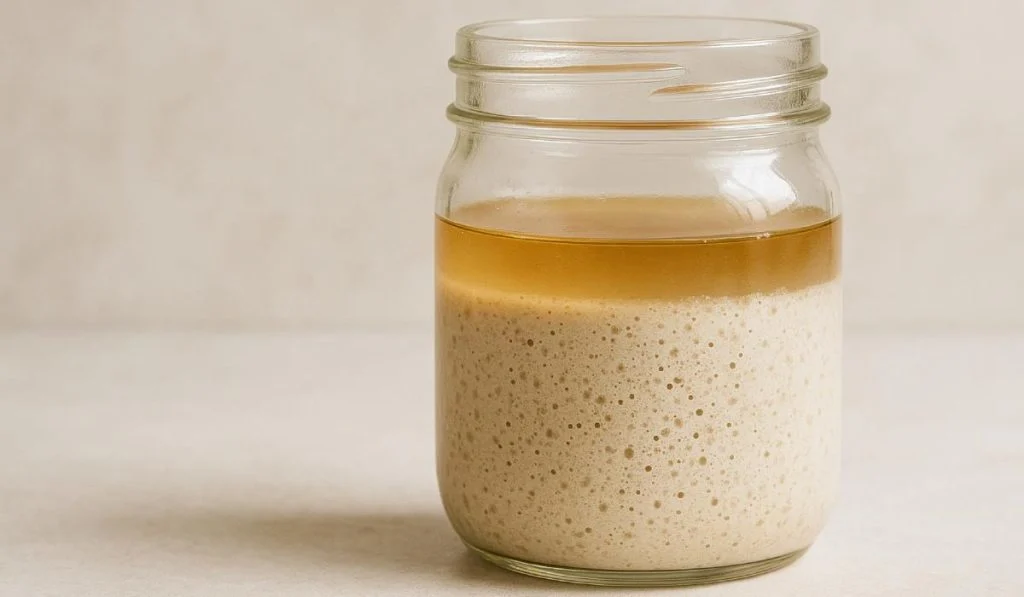Ever peek into your sourdough jar and find a mysterious layer of liquid lounging on top? That grey-ish or even dark layer is commonly called “hooch.” It might look scary, but actually, it’s a sign your starter’s alive—and plotting its next big rise! Let’s uncover what that liquid means, how to handle it, and even why it might turn your bread into a flavor superstar.

You spot a pool of liquid—hooch—snuggling atop your starter. Panic ensues. Is it ruined? Toxic? A sign to toss it? You wonder: will this kill your loaf? Should you start a new starter? The kitchen’s getting dramatic, and suddenly your sourdough mojo is on shaky ground. Let’s calm the chaos. That liquid is harbinger, not horror. We’ll break it down: what hooch is, how to responsibly handle it, insider tips on prevention, creative ways to use it, and pro-level tweaks to up your crumb game.
TL;DR — Key Takeaways
- Hooch is the alcohol–water byproduct of a hungry starter—totally normal.
- Stir or pour? Light amount? Stir into starter. Thick, dark layer? Pour off to control hydration and pH.
- Hooch impacts flavor: Stir it in for a tangier loaf; discard it for a cleaner taste.
- Prevention is power: Feed more frequently, adjust ratios, lower temperature, or fridge‑store.
- Pro tip: Use hooch in pancakes or discard bread—no waste, bonus fermentation flavor.
What Is That Liquid? Unmasking Hooch
That liquid is commonly referred to as hooch—a grey-to-dark, slightly alcoholic layer formed when wild yeast exhausts all available flour and hydration. It’s a byproduct of anaerobic fermentation: yeast nibble starches, puff out CO₂, and excrete water + alcohol. Think of it like your starter sending you a text that says, “Hey, I’m starving over here!”
The appearance of hooch often surprises beginner bakers, but it’s perfectly normal. Depending on how long your starter has been left unfed, the liquid can range from clear to yellowish to even murky brown or grey. The darker the hooch, the longer the starter has gone without food—and the stronger the aroma. Some bakers even say a darker hooch signals a “sleepy” starter that’s longing for a hearty meal.
It’s harmless, and a sign your starter is doing what it’s meant to do—alive, active, and waiting for the next feed. In fact, hooch shows that the yeast and bacteria in your jar are still metabolizing sugars and creating their signature tangy flavors, even if the activity has slowed down.
Some old-school bakers consider hooch their starter’s “badge of patience.” Watching my grandmother’s sourdough starter in a mason jar on a warm Texas windowsill, the hooch forming every couple of days like clockwork. My grandmother would say, “When the sourdough cries, it’s ready for supper.”
Stir or Pour? Choose Your Adventure
- Light hooch: A thin, clear sheen or faint yellow layer on top? No worries. Stir it back into the starter to retain hydration and add nuance to your bread. This is especially helpful if you prefer a slightly tangier loaf since the alcohol and acids in hooch contribute to that sour, funky depth.
- Heavy, dark hooch: A thick, grey, or brown layer? Pour it off. This helps avoid unbalancing the starter’s hydration and reduces the risk of developing too much acidity that might inhibit yeast activity. If your starter smells intensely like acetone or nail polish remover, that’s another sign it’s time to pour the hooch off and give your culture a double feed to revive it.
- Flavor matters: Stirring hooch in yields a bold, tangy, almost yogurt-like sourness in your dough—perfect for fans of a strong San Francisco-style bite. Discarding it produces a cleaner, milder taste that’s more kid-friendly or better for enriched breads like brioche or milk loaves.
Some bakers even experiment by saving their hooch and using it to flavor pancake batters, adding an unexpected tang and depth.
Why It Forms: Peek into Starter Biology
When your starter goes hungry, the yeast and bacteria shift from their bubbly, active phase into a survival mode. Without fresh flour to munch on, they slow their metabolism and begin releasing alcohol and acids, which rise to the surface and separate from the thicker flour paste below. This separation creates that watery layer of hooch.
The starter’s pH also drops due to the buildup of lactic and acetic acids, which is why a neglected starter often smells sharper and more acidic than usual. This isn’t bad—it’s nature’s way of preserving the starter, as the acidic environment protects it from harmful bacteria and mold.
In cooler environments, such as when the starter is stored in the fridge, yeast activity slows to a crawl while the bacteria keep producing acids, leading to a gradual buildup of hooch over several days or even weeks.
Interestingly, some bakers deliberately let their starter form a bit of hooch to develop a stronger, more complex flavor profile. My insider tip? “If you want a loaf with extra twang, don’t freak out about a little hooch—embrace it like a secret ingredient from your starter’s wild side.”
Insider Prevention Tips
- Feed smart: Move from 1:1:1 to 1:2:2 or even 1:3:3 ratio to give yeast better sustenance and slow hooch build-up.
- Temperature control: Starter thrives at around 70‑75 °F. Keep cooler for less frequent feedings, or move warmer to bake soon.
- Use the fridge: For infrequent baking, chill your starter for up to a week to reduce feed frequency.
- Jar matters: Use a wide-mouth jar to help inspect and stir starter. Good airflow helps too.
Flavor and Digestibility Benefits
That hooch might actually be doing your bread good! The alcohol and acid break down gluten, making loaves easier to digest. Stir it in and harness a gut-friendly tang and deeper aroma. It’s like a secret fermentation superpower you never knew you had.
Creative Uses & Waste–Not Attitude
- Pancakes, waffles & biscuits: Stirred-in hooch amps flavor and yogurt-like tang—plus a digestive aid.
- Discard loaves: Incorporating hooch-sprinkled starter adds a layered, tangy flavor profile.
- Alcohol for bread improver: Use hooch instead of water in dough; adjust flour to maintain dough consistency.
Personal Twist
I remember waking up one morning and seeing my starter split with a thick, dark layer of hooch on top. At first, I thought, “Well, that’s it… I’ve killed it.” But instead of tossing it, I stirred the hooch back in and gave it a hearty 1:2:2 feeding. A few hours later, that starter came roaring back to life—bubbling and rising like nothing had happened. And the loaf I baked next? Oh my goodness. It had a chewy, crackling crust, an aromatic, tender crumb, and this tangy flavor that danced on my tongue like a folk song.
From that day on, I stopped seeing hooch as a bad sign. Now I think of it as my starter’s way of saying, “Feed me, and I’ll reward you.”
Personal Conclusion
That pool of liquid isn’t a doom sign—it’s a signal: your starter is alive, hungry, and ready for its next rise. Light hooch? Stir it in. Thick hooch? Pour it off, revive with a robust feeding routine. And hey, don’t just toss it—shake things up in your pancakes, or add depth to your sourdough loaf.
Insider’s secret tip: when life gives you hooch, make tangy, gut-friendly magic!
FAQs
What exactly is the liquid on top of my starter?
It’s called hooch—a mix of water and alcohol produced when your starter is hungry and hasn’t been fed in a while.
Is it okay to pour it off?
Absolutely: if the layer is thick or dark, pour it off to maintain hydration and prevent overly acidic sourness. For lighter layers, stirring it in is fine.
Can I still bake with starter that has hooch?
Yes! Stirred-in hooch doesn’t harm baking activity; heavy hooch just signals you should feed more often.
Does hooch affect loaf flavor?
Definitely. Stirring it in adds sour, tangy, nuanced flavor; discarding gives a cleaner taste.
How often should I feed to avoid hooch?
Feed daily at 70–75 °F; colder environments or fridges allow for weekly feedings.
Can I use hooch in recipes?
Yes! Use it in pancakes, biscuits, or even in dough for flavor and probiotics.
Does stirring hooch affect hydration?
Yes—you may need to adjust flour/water slightly after stirring to maintain consistent hydration.
Is dark hooch a sign my starter is unhealthy?
No, it only means starvation. Feed twice daily until it’s bubbly and vocal again.
When should I discard my starter?
If you see mold (pink/orange fuzz), or smells rotten beyond acidic tang, it’s safer to start a fresh batch.
What’s the best starter jar?
A wide-mouth, clear glass jar with measurement marks helps monitor activity and hooch level.
Join Us and Transform >
Don’t Be an Amateur! Master the Art of Sourdough Bread!




Leave a comment